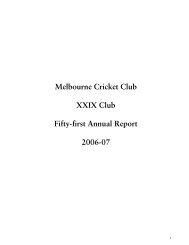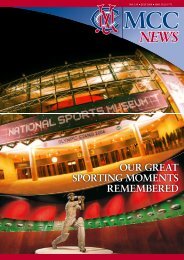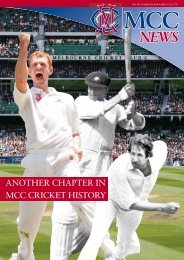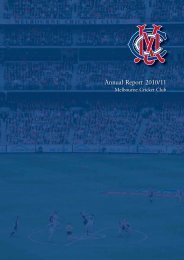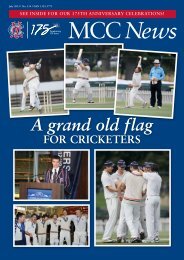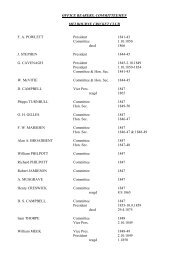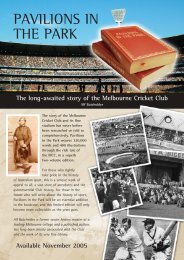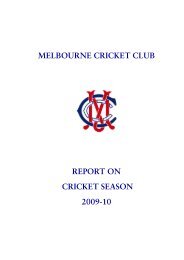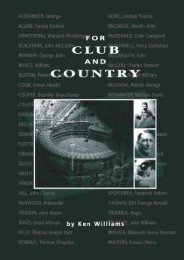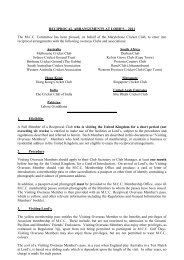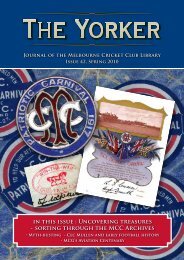Issue 36: Summer 2006/07 - Melbourne Cricket Club
Issue 36: Summer 2006/07 - Melbourne Cricket Club
Issue 36: Summer 2006/07 - Melbourne Cricket Club
You also want an ePaper? Increase the reach of your titles
YUMPU automatically turns print PDFs into web optimized ePapers that Google loves.
The Pavilion ClockIn late November 2004, as part of preparing research for the MCCMuseum and the National Sports Museum’s MCG Exhibition,Library staff and volunteers were comparing documentationon the MCC collection holdings. One item that was listed forinclusion in either exhibition was a large clock, which was thendisplayed in a heritage module of the Great Southern Stand (GSS).This was described as the clock originally displayed on the secondMCC Pavilion, erected in 1881 and demolished in 1927. The clockhad been moved to another stand for 25 years before being storedfor more than 35 years, then cleaned and displayed as a staticobject in one of the MCG heritage modules.A site inspection of the object was required, and after lunchingwith a group of the Library volunteers in the GSS the followingMonday, we headed down to the modules on Level B1 in searchof the clock. Once found, we noted that Roman numeral hourmarkings were faintly visible underneath the present simplemarkings on the face of the clock, showing through from wherethey had been painted over at some time.Upon returning to the temporary library we started to lookthrough old pictures of the clock on the 1881 Pavilion. In thepossession of the MCC Museum are two photographs by W. Lindtof <strong>Melbourne</strong>. These were taken one morning around the timeof the completion of the second Pavilion in December 1881, andshow the first and second Pavilions side by side. (The first Pavilionwould not be demolished until after April the following year, asboth were required for the 1881/82 season tour by Alfred Shaw’sEnglish XI.)It was then that the revelation hit. If the face is the same and thecase looks similar could this clock not just be from the secondPavilion, but also from the first?!? A detailed examination offurther photographs in the Museum and Library collectionsranging from the 1870s to the 1920s revealed the same distinctivenumerals on the clocks on both pavilions. Using scans of the 1881photographs and similar views of the second Pavilion taken onceits clock was installed, it was possible to work out a consistentscale that showed that the clocks not only looked the same, butwere indeed the same size. However, the photos showed that thebacking board of the original wooden casing was wider than thesmall casement on the front of the second Pavilion. It would havehad to be removed from the clock to allow for easy installationonto the front of the second Pavilion.A check of the MCC Committee minutes for 1881 and 1882 for anymention of the clock revealed that the <strong>Club</strong> had originally plannedto sell the 1863 clock and purchase a new one to install on thenew Pavilion. However, the construction costs for the new pavilionwere over the original allocation of £3000 and this had resultedin a reduction of decorative finishings from the original proposal.The minutes also noted that there was no buyer for the old clock,and neither they nor the financial reports reveal the purchase ofanother one. Therefore, it appeared likely that a cost saving wasmade and the clock was simply transferred across from the oldpavilion to the new.With this further evidence making it more likely that the clockmay indeed have been from the first Pavilion, it was decided toseek some authentication from a clock expert, preferably oneaccredited with the Australian Government’s Cultural Gifts andProtection of Moveable Cultural Heritage programs.Ronnie Bauer, of Klepner’s Jewellers and Valuers, fitted the billon all counts. Ronnie was able to verify that the dial and surroundof the clock were indeed consistent with those made in the 1850sand 1860s. He noted that the hands and over-painting on the dialwere actually from the 1920s – also consistent with the originalones remaining with the clock in all of our photographs of thesecond Pavilion up to its demolition in 1927.The photographs revealed a vacant space on the front of the 1881pavilion with a small casement housing awaiting the fitting of aclock, while the original pavilion still retained its clock, shownsitting flush against the face of the arched gable built to containthe clock and its mechanism in 1863. A magnification of this clockon the 1854 pavilion clearly showed Roman numerals aroundthe face. Indeed they were so clear that they almost leapt off thephotograph, the distinctive IIII for the 4 instantly reminding usof the faint numerals that had been seen less than a half-hourearlier on the clock in the heritage module.The Yorker - <strong>Summer</strong> <strong>2006</strong>/<strong>07</strong>
Researching HughieIn researching Pavilions In The Park, I became particularlyinterested in some of the key figures associated with the<strong>Melbourne</strong> <strong>Cricket</strong> <strong>Club</strong> and its Ground. I was fascinated bythe contribution of amateurs like Andrew Stoddart and ArchieMacLaren, who led some of the English teams organised by ourclub. The MCC’s records led me to appreciate the enormousimpact of leaders like Frank Grey Smith and Vernon Ransford.I saw that they were men of great integrity, whose approach tolife in general had been shaped by their love of cricket. A fewindividuals, though, left me quite cold – for example, I remainappalled by one English captain whose assault on the principlesof sportsmanship was utterly out of keeping with anything that thegame had previously seen. Some figures remained slightly veiled.Major Wardill, for instance, was an outstanding administrator,but there were times when he did not leave detailed accountsof his actions, and so a few mysteries remain. However, no onefascinated me more than Hugh Trumble.The modern era has seen much discussion about the skills ofShane Warne. Many now regard him as the greatest bowler of alltime. While he has indeed taken more wickets than anyone else,Warne has also enjoyed a remarkable number of opportunities.However, I find it hard to accept that his skills are significantlybetter than the great bowlers of the past. A century ago, it wasTrumble who was regarded as the game’s greatest bowler.Consequently, I am keen to trace the evolution of his cricketcareer, but Hughie, as I call him, is interesting for other reasonsas well. Renowned for his humour and his approachability,Trumble was probably the most popular and widely recognisedsecretary that the MCC has ever had. Like Grey Smith, his viewson life were profoundly shaped by his love of the game and itsbasic principles. Moreover, he led the club through difficulttimes, especially during World War I, and was involved withmany personalities who are highly interesting in their own right– Monash and Sir Leo Cussen, to name but two.Hugh Trumble was born 139 years ago, and died in 1938.Consequently, he belongs to an age that risks being forgottenin the flood of modern cricket and the marketing and promotionthat accompany it. As L.P. Hartley wrote, “The past is a foreigncountry; they do things differently there.” In 1890, the youngTrumble made his first trip to England – he found it an interestingand very different experience.Alf BatchelderDeserved RecognitionAmong the many personal achievements of the Library volunteers this yearinclude the successful publication of Alf Batchelder’s Pavilions in the Park – anauthoritative and comprehensive history of the MCC and MCG. It was a labour oflove at least eight years in the making.Alf was honoured recently with the Jack Pollard Trophy [left] by the Australian<strong>Cricket</strong> Society as the author of the outstanding cricket book of <strong>2006</strong>. The trophyis currently on display in the MCC Library foyer.The Yorker - <strong>Summer</strong> <strong>2006</strong>/<strong>07</strong>
Treasures from the Collection- Rare <strong>Cricket</strong> Trade CardsA.C. MacLaren’s team 1901/02 by McCracken’s City Brewery LtdAfter losing the First Test in Sydney by an innings, Australia wenton to win the next four Tests, by 229 runs in <strong>Melbourne</strong>, by 4wickets in Adelaide, by 7 wickets in Sydney and, finally, by 32 runsin <strong>Melbourne</strong>.The newly opened MCC Museum recently acquired a stunning“set” of early and extremely rare Australian cricket trade cards.The cards depict 12 of the 14 members of Archie MacLaren’sEnglish team which toured Australia in 1901/02 and were issuedby the <strong>Melbourne</strong> company McCracken’s City Brewery Ltd. Thefeatured players are: A.C. MacLaren (Captain), S.F. Barnes, L.C.Braund, C. Blythe, H.G. Garnett, J. Gunn, T. Hayward, G.L. Jessop,A.O. Jones, A.A. Lilley, W.G. Quaife and J.T. Tyldesley. The twomissing players from the collection are C.P. McGahey and C.Robson and to date neither of these cards has ever been seen.Neither Garnett, who was killed in action in France in 1917, norRobson played a Test match during the tour.Another snippet of interest is that the amateur members of theside, MacLaren, Garnett, Jones, Jessop, McGahey and Robson,were made Honorary Life Members of the <strong>Melbourne</strong> <strong>Cricket</strong><strong>Club</strong>. i Indeed A.C. MacLaren’s team was the last of the Englishteams that toured under the auspices of the <strong>Melbourne</strong> <strong>Cricket</strong><strong>Club</strong>. From Pelham Warner’s 1903/04 team until the 1977Centenary Test side, the English played in Australia under theauthority of the Marylebone <strong>Cricket</strong> <strong>Club</strong>.The cards consist of black and white portraits of the players,surrounded by borders of dark blue enclosing bars of red andwhite checks. This design was clearly taken from the team’suniform. In the article entitled Arrival of MacLaren’s team inAdelaide, published in the Australasian of November 9, 1901(p.1047) it is noted that, “The English cricketers ... were easilydistinguishable by small red and white checks on their blue hatbands.” (These bands can be seen in pictures of players in theAustralasian, November 16, 1901, p.1118.) While the red, whiteand blue could be considered their national colours, taken fromthe Union Flag, they could also be seen as the colours of theteam’s sponsoring club.A similar set of cards featuring the same touring players wasissued by Hordern Bros. a Pitt Street, Sydney department store.R. McCracken & Co’s brewery was founded by Robert McCrackenin Collins Street, <strong>Melbourne</strong> in 1851, the same year gold wasdiscovered in Victoria. The thirst of the huge influx of minersflocking to the goldfields increased business manyfold and it grewsteadily until the disastrous financial depression of the 1890s.The company managed to survive until 19<strong>07</strong> when, with fiveother breweries, it merged into Carlton & United Breweries Ltd.Robert’s son, Alexander, who had been the managing director ofMcCracken City Brewery Ltd, became a director with CUB uponthe merger. The impressive group of buildings, which formed themassive brewery works, were located opposite where today’sRialto Tower stands. The brewery was demolished by Jim Whelan(of Whelan the Wrecker fame) not long after the merger.Alexander McCracken was the man in charge at the time thecricket cards were produced. He must have been quite anamazing man for among his many interests he was the firstsecretary and later president of the Essendon Football <strong>Club</strong> andlater, when the Victorian Football League broke away from theVictorian Football Association, he became the inaugural presidentof the new football body. His biography reveals he was either thefounder, president or patron of some 17 sporting and civic bodies.Somehow, in 1894, he found time to unsuccessfully stand for theLegislative Assembly against Alfred Deakin who later became thesecond Prime Minister of Australia. He died, aged 59 in 1915, inhis beloved Essendon, the suburb he had devoted so much of histime, energy and money to. His portrait hangs in the EssendonFootball <strong>Club</strong>’s rooms.The twelve cards are now prominently displayed in the cricketanasection of our magnificent new MCC Museum.Acknowledgements.<strong>Melbourne</strong> <strong>Cricket</strong> <strong>Club</strong> Museum<strong>Melbourne</strong> <strong>Cricket</strong> <strong>Club</strong> LibraryLa Trobe Library, <strong>Melbourne</strong>.Sources.The Australasian, 1901.Australian Dictionary of Biography, Vol.10.Robyn Annear, A City Lost and Found.Eric Panther and Ken WilsoniMinutes of MCC Committee Meeting, February 21, 1902.“Members’ badges to be presented to professionals in Englishteam. Honorary Life Memberships to the 5 Amateurs of the Team.”The Yorker - <strong>Summer</strong> <strong>2006</strong>/<strong>07</strong>
BOOK REVIEWSPonting, Ricky withMurgatroyd, BrianAshes Diary 2005: From Victory in Indiato the most dramatic Test series of thecenturyHarper Collins: Sydney, 2005ISBN: <strong>07</strong>32281520For many Australian cricket fans, the 2005 Ashes Series left aperpetual heartbreak. Ricky Ponting provides a very personalaccount of this memorable period as captain of the Australianside. Beginning with the Sri Lankan Top End Tour in June 2004,the Ashes Diary 2005 gives insights into Ponting’s county cricketdebut with Somerset in England, as well as the Videocon Cup andICC Champions Trophy. Ponting expresses his disappointment atmissing the majority of Australia’s victorious Test tour of Indiaas a result of a fractured thumb. Also well accounted for are thefollowing tours of New Zealand and Pakistan in Australia, theTsunami match, the VB series with the West Indies and Pakistan,and the Test and one-day tour of New Zealand that also includedthe first Twenty20 international.The most significant piece from The Ashes Diary 2005 is thatwhich focuses on the dramatic Australian tour of England in thesummer of 2005. The past year had been leading up to this pointand Ponting portrays his anguish of the inevitable loss of theAshes to England. Ponting gives a candid response to the failuresof Australia which led to the loss of the Ashes. It is interestingto note the high praise he gives his fellow Australian teammatesthroughout Ponting’s reflection. At the same time he givesemphasis to the dramatic tie in the NatWest Series and victory inthe NatWest Challenge. Also included is an in-depth section ofthe 2004/05 statistics period, compiled by Ross Dundas.The Ashes Diary 2005 is the third contribution by Ponting ascaptain of Australia and provides a valuable account of eventswhich led to the Ashes clash and arguably the most dramatic TestSeries of the century. It is a captain’s story with notable highs, yetwill be most known for its dramatic lows. It is a considerable readfor any cricket lover, a delight for whichever side of the fence youhappen to be on. It also provides a nice curtain-raiser to the much-anticipated <strong>2006</strong> Ashes Series.Nathan CaddenPonting, RickyCaptain’s Diary <strong>2006</strong>: Australia’s Road tothe Battle for the AshesHarper Sports: Sydney, <strong>2006</strong>ISBN 10: 0 7322 8153 9ISBN 13: 978 0 7322 8153 3The fourth in Ricky Ponting’s diary series, the <strong>2006</strong> version (coauthoredby Geoff Armstrong) covers the period between October2005, when a World X1 visited Australia, and April <strong>2006</strong> whenthe short tour of Bangladesh concluded. During this 25-weekperiod, the Australians played 25 One Day Internationals, 12 Testsand two Twenty/20 Internationals. Thirty players were used andthe matches were played in four different countries. Only sevengames were lost, none of them Tests, a formidable record forany captain.In the first section of the book, Ponting looks back to the difficultperiod following the loss of the Ashes. He arrived home to theinevitable speculation about his role in the defeat, Dennis Lilleeleading the charge and nominating Shane Warne as a betterproposition if the Ashes were to be regained. Ponting admits thathe was hurt by the criticism, but could not afford to overreact.Unfortunately he doesn’t spend enough time on his personalresponses to the criticism, instead shifting the discussion to thereview of the team’s performance carried out by <strong>Cricket</strong> Australia.It is all just a bit too bland, a characteristic which, unfortunately,is typical of this genre. For example, statements such as: “I havealways said that if we can focus on things we can do, rather thanworrying about outside things that are beyond our control, we cancompete with any team in the world”, become rather tedious.The main problem with the book as a whole is that the diaryformat is followed religiously. Every game is commented on inat least some detail. Even the most creative of observers wouldfind it difficult to find something of real interest to say abouteach of the 25 one day games Australia played during the periodcovered. Ironically, although Ponting gives his personal thumbsdown to the concept of Twenty/20 cricket at the internationallevel, the short chapter spent on the game in Brisbane againstSouth Africa is of comparative interest, if only because it issomething a little different.Perhaps the subtitle of the book gives the game away. After theAshes were lost in one of the finest series ever played, everythingthat happened in the 18 months before the return clash inAustralia was going to be seen as a prelude. The series againstSouth Africa began with plenty of hype, but the reality was thatthe best they could do was force one draw in the six Tests played.The severely undermanned West Indians were never going toprovide a real contest and Jason Gillespie scored a double centuryagainst Bangladesh. One hundred and thirty pages are allocatedto coverage of the Test matches. The final 86 pages contain thescore cards from every game played, as well as the averages foreach series. The next diary should be more interesting.Denis CarrollThe Yorker - <strong>Summer</strong> <strong>2006</strong>/<strong>07</strong>
Thompson, HarryPenguins Stopped Play:Eleven Village <strong>Cricket</strong>erstake on the World.John Murray (Publishers):London, <strong>2006</strong>ISBN <strong>07</strong>195 6345 3This is a delightfully entertaining book which I consumed whilewatching our Ashes heroes strut their stuff recently on thebeautiful Adelaide Oval. It is the story of the life and times of theCaptain Scott Invitation XI, a village green cricket team whichbegan life among a group of students at Oxford University.The team continued to play both at home and abroad over a25-year period and at one stage did a whirlwind three-week roundthe world tour to enable it to play on all continents.The author was a storyteller. His story highlights the eccentricityof the British and the bulldog-like tenacity which served themwell during their round the world trip when everything that couldgo wrong generally did! It is at times Monty Pythonesque witha tinge of the Goons. Some of the characters in and aroundthe team are a delight. How could one come to be travellingin Uzbekistan with a full set of Wisdens and then lose them?Hugh Grant (alias Captain Peacock of BBC fame) was a teammember as were the O’Herlihy brothers, lawyers of part Irish/partMalaysian extraction who played in shades and ponytails. Thebrothers did not excel at cricket but were invaluable in “tightcorners on far-flung fields”. One of the four however paid lipservice to his responsibilities, preferring to spend the weekend inbed with his Swedish girlfriend rather than immersing himself inthe raw pulsations of village green cricket. Then there were thestockbrokers in their Gucci pads……...!Thompson was, from time to time during his working life, a traveljournalist. His writings on the team’s travels and his impressionsof places visited are informative, witty and stylish.This may not be one for the connoisseur or the cricket tragic orthose who thirst after accounts of the exploits of the elite playersand immerse themselves in voluminous servings of statistics. Itis escapism, well presented and entertaining. Sadly, the authordied soon after finishing the book. He may well have finished hisfinal story under threat from the illness which took his life.Ross PerryHaigh, Gideon.The <strong>Summer</strong> game: <strong>Cricket</strong> andAustralia in the 50s and 60s.ABC Books & Audio, <strong>2006</strong>.ISBN : 978<strong>07</strong>33320033ABC Books have just reissued an updated edition of GideonHaigh’s The <strong>Summer</strong> Game to coincide with the release of their<strong>Cricket</strong> in the 50s and <strong>Cricket</strong> in the 60s DVDs.The editors did not think they could improve upon Ross Peacock’sreview of the original edition, published in The Yorker No.16, sowe are reprinting that for your enjoyment.This is clearly the best cricket book that I have reviewed in thefour-year history of The Yorker.It really amazes me that its author, Gideon Haigh, is only 31years of age and continues to provide more graphic and colourfulwriting than many of the other more “mature” cricket scribes.What is more, Haigh is talking in this book about an era throughwhich he did not, for the most part, live. To find Gordon Rorke(of the late ‘50s and early ‘60s) described as “husky” recalls mymental image of the NSW paceman in the most vivid manner. Sotoo the image of Ken “Slasher” Mackay, “a man with an allegianceto Wrigley’s gum so unstinting that he stockpiled enough to lastthe tour.”The author’s use of evocative language is again demonstratedin a sentence discussing the Third Test, Australia v South Africa,at Durban in 1950 when Neil Harvey made 151 not out. Harveyhad to graft for his runs: “So used to dictating terms to bowlers,Harvey found the experience disorienting. It was taking so long.He was actually practising, and counselling, caution.” Ratherthan just describing the “play” or giving “the scores”, Haigh digsdeeper and deeper into the psyche of Australian cricket at homeand abroad and, largely through new material gained by oralinterview, paints a picture of what it was really like to playTest cricket.Who drank with whom and why, and who didn’t. The tradesor professions of the players, and how these impinged onmany career directions; the state of the economy and thecontribution of cricket to it; the pressures of raising a familyand staying in cricket.For this is definitely also a social, economic and political history,throwing new light, for instance, on the love of cricket held by SirRobert Menzies and just how much he would do for anyone who“played the game” to his liking. Before the Test matches startedon the 1953 tour of England, Menzies threw a huge dinner in theRiver Room of the Savoy Hotel, London. No expense was spared,including steaks shipped over from Australia for the occasion.The PM recited a 23-verse poem as an ode to the Aussies, thepoem appearing in full in the appendix. Health and fitness is alsoan ongoing issue in the book, from the temporary vegetarianismof Frank Misson to the ill-health suffered by a large number ofplayers such as Lindsay Kline and Alan Connolly when touringthe subcontinent.The <strong>Melbourne</strong> <strong>Cricket</strong> <strong>Club</strong> gets some attention too, and thealleged “watering of the wicket” incident in the 1955 <strong>Melbourne</strong>Test is aired, partly through the testament of Ian Johnson who ayear later became MCC secretary.Altogether a book which I could not put down, and would fullyrecommend to any Australian History class.Ross Peacock10The Yorker - <strong>Summer</strong> <strong>2006</strong>/<strong>07</strong>
Also recommended…Hilton, ChristopherThe Birth of the Ashes: The AmazingStory of the First Ashes TestRenniks Publications:Banksmeadow, <strong>2006</strong>ISBN 10: 09752245 4 9ISBN 13: 9780 9752245 4 0A extensively researched book recreating ball-by-ball the historic1882 match at the Oval. Also covered in depth are the eventsof Ivo Bligh’s tour to Australia with discussion on the events atRupertswood that led to the creation of the Darnley Ashes urn. Ofspecial note to historians of the mythical ashes are photographicreproductions of Lady Darnley’s handwritten notes for hercommentary on the origin of the little ashes urn.Panckridge, Michael with Lee, BrettToby Jones and the Mystery of theTime Travel Tour.HarperCollins: Sydney, 2005ISBN: 02<strong>07</strong>199981Ann RusdenToby Jones is not your average young cricket fanatic. On a visitto the MCC Library, he discovers he has a rare ability: by readingthe Wisden account of a cricket match, he can travel back in timeto that match. But there is danger as well as excitement in thistalent: to stay in a previous time for more than two hours meansrisking death.In Toby Jones and the Mystery of the Time Travel Tour, the thirdtitle in the series, Toby finds himself pursuing Phillip Smale, themanager of a rival cricket club, who has stolen a magic scorecardthat allows him to time travel as well. Smale plans to set up abusiness taking well-heeled cricket fans back to watch classicmatches, but he doesn’t care if he leaves the odd customerbehind, although that means their death. Can Toby rescue thestranded fan? And can he stop Smale?With a couple of strong female characters as well, this lively mixof sport, adventure and fantasy is entertaining reading for cricketenthusiasts between nine and 12.The four Toby Jones books, by Michael Panckridge with Brett Lee,all set around the MCC Library, can be found throughhttp://www.harpercollins.com.au/.Deborah SchraderAndrew FlintoffBeing Freddie: The Story so FarHodder & Stoughton: London, 2005ISBN 0 340 89628 0As the title says, Andrew Flintoff has written his personal accountof his career in cricket to date. His cricket started with his signingwith Lancashire when aged just 15 and the next year signing asa professional. His first tour overseas the following year was tothe West Indies with the England Under-19s. His Test debut camewhen he was 20 and has been most successful since 2001, onthe tour of India. He has played an outstanding role in England’srecent successes in Tests culminating in the Ashes series of2005. However, like some other fast bowlers he has had hisshare of injuries.Readers who have followed England’s recent improvement inthe Test arena will find interest in reading this account astold by Flintoff himself, especially the highs and lows he hasexperienced and the insight he gives into the life of the modernprofessional cricketer with its routine practices and theworldwide travel involved.The last chapters describe the thrilling 2005 Ashes series and thecelebrations which followed England’s success. The final sectionconsists of statistics and records for Flintoff in Test cricket, oneday internationals and first-class cricket up to the end of the 2005Ashes Tests compiled by Vic Isaacs. It also lists the scorecards forthe Ashes 2005. It can be commended as good holiday reading forFlintoff admirers.Ann RusdenHaigh, Gideon [Editor].Peter the Lord’s Cat: And OtherUnexpected Obituaries from Wisden.Aurum: London, <strong>2006</strong>ISBN 1845131630This small, yet enjoyable collections of obituaries for the esotericand eccentric members of the cricketing fraternity has provena regular candidate for selection of the daily reading during theLibrary staff and volunteers’ morning tea. Entries read so far haveincluded the title feline, Samuel Beckett, Anthony Ainley (TheMaster from the Doctor Who series), P.G. Wodehouse, Bob Crisp(the only man in first-class cricket to take four wickets in fourballs twice), and the Rev. Reginald Heber Ross (whose two firstclasscricket appearances were a record 32 years apart). A mustfor all cricket readers.David StudhamThe Yorker - <strong>Summer</strong> <strong>2006</strong>/<strong>07</strong> 11
Vale Paul RigbyOn November 15, <strong>2006</strong> cartoonist Paul Rigby passed away. With the English cricketers touring the country this summer the MCCLibrary thought it appropriate to present Rigby’s insight into the 1974/75 Ashes series. An obituary for Paul Rigby may be found at www.theaustralian.news.com.au/printpage/0,5942,2<strong>07</strong>85454,00.html.In AffectionateRemembranceWith the opening of thenew MCC Library, ourpublishing program hasalso recommenced with InAffectionate Remembrance.The book expands uponthemes in the 2002/03Yorker Ashes supplement.In words and pictures itoutlines the origins ofthe Ashes myth in 1882and its subsequentrepresentationthroughout theensuing years. The96-page book retailsfor AUS$20.00 inc.GST and may bepurchased from theMCG Superstore.12The Yorker - <strong>Summer</strong> <strong>2006</strong>/<strong>07</strong>



